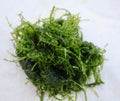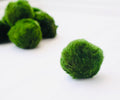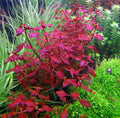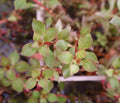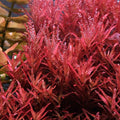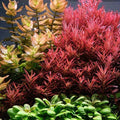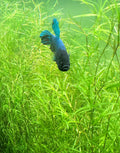Why People Use Indian Almond Leaves in Their Aquariums
Have you ever looked online and wondered why people use these things in their aquarium? But what is the purpose for them? Well, today I'm going to tell you why.
Why Add Leaves to Your Aquarium?
There are a few different reasons why people would use leaves in their aquariums.
Number one is for the visual look. It's always great to have that nice, natural-looking fish tank for your fish. But also, some people use them for a more functional purpose.
Some, for example, can be used as food for shrimp, or others can be used as a great sort of spawning area for various fish or shrimp.
Types of Leaves and Their Benefits
There are absolutely hundreds of leaves available around the world. But what exactly can you use in a fish tank?
There are a fair few online, and if you go on some of the more popular websites that sell various botanicals around the world, then you will probably see a fair few things like Indian almond leaves, guava leaves, mangrove leaves, or oak leaves.
Some of these leaves also do have various different benefits. For example, the Indian almond leaf—not only is that a real-looking leaf, but it also releases various minerals that can be beneficial to your fish and can also be used as a natural sort of medicine, if you will.
Especially for betta fish or Siamese fighting fish—whatever you want to call them—it can help with fin rot, it can help with white spot, that sort of stuff. So it's more of a natural remedy.
Why Indian Almond Leaves Are Amazing for Aquariums
Nettles are really good because they have a ton of different beneficial properties.
Number one: they are a natural fertilizer. So if you put them into your fish tank, they can be used to help fertilize the plants so you don't have to use an actual fertilizer bottle.
If you've got stinging nettles in your garden, then this can be a very cheap alternative.
Also, they produce a ton of minerals that can be beneficial to your fish and shrimp. And if you do put them in, then you might notice things like color difference and better health.
So it's a benefit and a win-win all around.
The Natural Habitat Connection
I think the biggest thing that many people ask is, "Why would I use leaves in my fish tank?"
Well, the obvious answer is because there are a ton of benefits to them. But what are their benefits?
If you think about the tropical freshwater fish that you have in the hobby, many of these come from various river streams around the world—specifically Asia or South America.
Now in these areas where they are complete rainforests, there will be loads of trees and foliage all above the river stream.
During certain periods of the year, those leaves will drop down into the river and land on the riverbed.
So when you look at these environments online, for example, you might see massive riverbeds just full of leaves or various other botanicals and pods—as opposed to just loads of plants and very clean, clear water.
What Are Tannins?
Many of the leaves produce an element called tannins. It's a natural substance that is released from various botanicals, but leaves are a very prominent one.
It will cause the water to go brown and murky.
Now I don't know if you've seen that online, but many people often have their fish tanks like that—and that is a purely intentional thing.
What that does is reduce line of sight for fish, and it can help them feel more comfortable within the environment they're in.
So it's helping release those natural behaviors in your animals.
The Shift from Fake to Natural
When they look at their fish tanks—I would assume, especially when you walk into a shop, you will see a very clear and pristine aquarium full of lots of plants. Now, plants are an absolutely amazing step forward in the right direction.
But it has come from a generation where you had fake plants and colored gravel and all these treasure chest bubble men and divers in the tanks and stuff.
So it’s all those ornaments—and you know, this is a nice step in the right direction.
If you're using leaves and botanicals, then you are introducing a whole new element to your fishkeeping experience.
The Rise of Natural Aquariums
There is a niche area in the hobby for this, and a lot of people are often called biotopiers or—you know—it’s often referred to as blackwater or natural aquariums.
Whatever you want to call it, essentially the idea of those types of fish tanks is to take all those elements from their natural habitats and try and help recreate some of those elements within their fish tanks.
And the reason you do that is because it could encourage
-
Better spawning behavior
-
More natural behaviors
-
Improved coloration
So there are just so many amazing benefits to this.
Collecting Your Own Leaves—Yes, You Can!
Now, obviously, you can go online and buy a lot of leaves. But also, some people would wonder:
"Why can't I go to my local woods and just pick up leaves that I found on the ground?"
Well, you can actually do that.
The most important thing to be aware of is
-
Just doing your research and making sure that you know the type of leaves that you're putting in.
-
Most leaves should be fine, but some can contain dangerous chemicals.
-
It's always best to be prepared.
There are many people that have tried and tested stuff—it's still early days with a lot of these elements—so some things haven't been tried and tested.
If you are daring to take the chance, then it would be best to do that in a more controlled environment.
So if you're going to try out leaves that you haven't seen the research for, then maybe put them in a body of water and do some various testing on them before you add them to an actual fish tank and introduce them to your animals.
Tips for Safe Leaf Collection
Personally, my recommendation if you did find any leaves that you wanted to collect:
-
Make sure, number one, they are completely dry.
-
Dried out. So they're not green. They're dead. Completely dead.
-
They've also fallen from a tree naturally—so you haven’t just climbed a tree and pulled them off.
-
Remember that we want to keep our environment safe, and we don't want to cause any more damage to it than we already do sometimes.
And again, the third one is purely optional, but it's highly recommended:
-
When you do get those leaves, bring them home, stick them in a saucepan, and boil them for at least half an hour to an hour.
-
Just make sure that you boil them, because many of the leaves can be found in certain areas—and what you might find is that various animals have urinated on them, or they could be in polluted areas.
Again, if you are searching for leaves, make sure that you are in the middle of a woodland, as far away from any kind of pollutants as you can.
That's like near a road or anything like that—so it's kind of a big no-no.
You don't want all those harmful chemicals that come from cars or other vehicles introduced into your fish tank and harming your animals.
So it's always best to do this in a more controlled environment.
-
Take them.
-
Boil them.
-
Then drain the water from the boil that you've just done.



